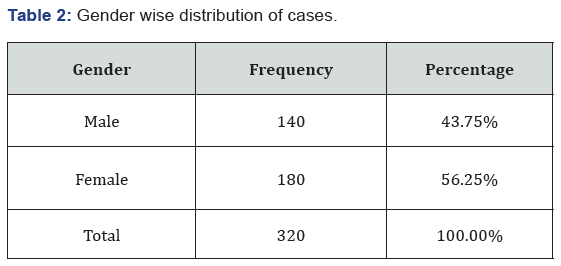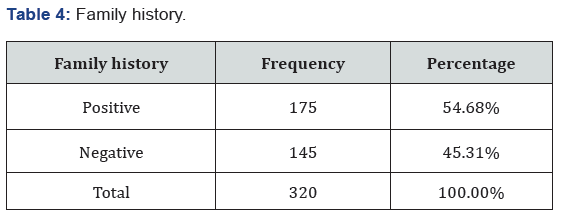Hyperhidrosis and its Prevalence in a Population: A Cross Sectional Survey
Mubashar Mashqoor Mir1* and Mohammad Sarwar Mir2
1Department of Dermatology, Government Medical College, India
2Senior Resident, Department of Hospital Administration, India
Submission: May 21, 2018; Published: September 24, 2018
*Corresponding author: Mubashar Mashqoor Mir, Post Graduate Resident, Department of Dermatology, Government Medical College, Jammu, India, Email: mohammedsarwarmir@gmail.com
How to cite this article: Mubashar M M, Mohammad S M. Hyperhidrosis and its Prevalence in a Population: A Cross Sectional Survey. Ann Rev Resear. 2018; 3(4): 555617. DOI: 10.19080/ARR.2018.03.555617
Abstract
Background
Hyperhidrosis is a quite common condition. There is a wide variation in the reported prevalence of hyperhidrosis in the available literature.
Objectives
This study aims to examine the prevalence of hyperhidrosis [1].
Methods
A cross sectional survey of a population was carried out. The subjects were classified to have hyperhidrosis using the criteria of International Hyperhidrosis Society. The prevalence of HH was calculated for the entire study population.
Results
The prevalence of hyperhidrosis was 3.2% (320 cases) in the study population of 10000.
Conclusion
Hyperhidrosis affects a much larger population than previously reported.
Keywords: Prevalence, Hyperhidrosis, Population; Cross-sectional study
Introduction
Hyperhidrosis (HH) is a condition characterized by excessive sweating without the usual triggers such as mental, physiological or thermal stimuli. There are two broad categories of hyperhidrosis, secondary and primary. Secondary hyperhidrosis occurs with an underlying medical condition, such as chronic infections and other catabolic conditions [1]. In contrast, primary hyperhidrosis (primary HH) occurs in a symmetrical fashion with an age of onset less than 30 years and without underlying medical conditions. While the significant negative impact of primary HH is well known, especially in developed countries [2] there have been large variations in the prevalence of primary HH in various reports, ranging from 2.8% in the United States [3], to 16.3% in Germany [4] and 12.8% in Japan [5], the reasons for the discrepancies are not known. However, the demographical and geographical aspects of various studies differ from one study to the next. Further, the criteria used for the diagnosis and classification of HH also varied from study to study.
Methods
It was a cross sectional survey carried out in a rural community in Srinagar in April 2014. The subjects were classified to have hyperhidrosis using the criteria of International Hyperhidrosis Society. The prevalence of HH was calculated for the entire study population. The questionnaire contained the following components: age, sex, reasons for presenting for dermatological assessment, symptoms related to day-time.
Statistical Analysis
The data analysis was performed with Microsoft Excel and SPSS 20. The prevalence of HH was measured for the whole population.
Discussion
Hyperhidrosis (HH) is a condition characterized by excessive sweating without the usual triggers such as mental, physiological or thermal stimuli. There are two broad categories of hyperhidrosis, secondary and primary. Much of the current knowledge is directed on treatment while only a few studies are focused on determining the prevalence. In our study the prevalence of hyperhidrosis was 3.2%. The prevalence of primary hyperhidrosis has been the subject of examination by several groups focusing on populations that differ in ethnic compositions, geographical locations, age, and gender. However, the findings vary from one study to the other: 2.8% in the United States [3], 4.4% PPH in Fuzhou, China [6], 16.3% in Germany [4] and 12.8% in Japan [5]. Possible reasons for the wide variation may include differences in study methods, precise definitions used, ethnic composition of the study subjects, age, gender and the environment. Females were the dominant sex affected in our study and also axillary hyperhidrosis was the commonest site affected. Also, majority of the patients had positive history of hyperhidrosis. Further studies are needed to understand the distribution, and effect of hyperhidrosis in this part of world and to identify the aggravating factors (Tables 1-4).




References
- Liu Y, Bahar R, Kalia S, Huang RY, Phillips A, et al. (2016) Hyperhidrosis Prevalence and Demographical Characteristics in Dermatology Outpatients in Shanghai and Vancouver. PLoS ONE 11(4): e0153719.
- Gross KM, Schote AB, Schneider KK, Schulz A, Meyer J (2014) Elevated social stress levels and depressive symptoms in primary hyperhidrosis. PLoS One 9(3): e92412.
- Strutton DR, Kowalski JW, Glaser DA, Stang PE (2004) US prevalence of hyperhidrosis and impact on individuals with axillary hyperhidrosis: results from a national survey. J Am Acad Dermatol 51(2): 241-248.
- Augustin M, Radtke MA, Herberger K, Kornek T, Heigel H, et al. (2013) Prevalence and disease burden of hyperhidrosis in the adult population. Dermatology 227(1): 10-13.
- Fujimoto T, Kawahara K, Yokozeki H (2013) Epidemiological study and considerations of primary focal hyperhidrosis in Japan: from questionnaire analysis. J Dermatol 40(11): 886-890.
- Li X, Chen R, Tu YR, Lin M, Lai FC, et al. (2007) Epidemiological survey of primary palmar hyperhidrosis in adolescents. Chin Med J (Engl) 120(24): 2215-2217.






























